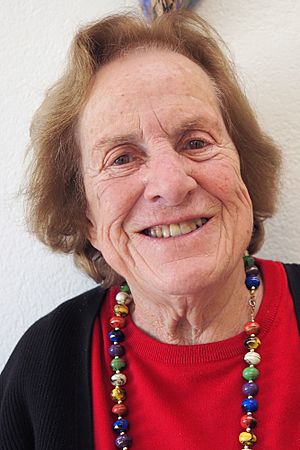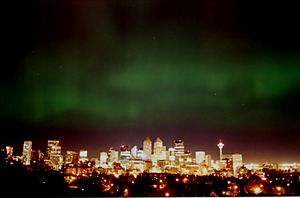Joan Feynman facts for kids
Quick facts for kids
Joan Feynman
|
|
|---|---|

January 2015
|
|
| Born | March 31, 1927 |
| Died | July 21, 2020 (aged 93) Ventura, California, U.S.
|
| Nationality | American |
| Alma mater | Oberlin College (BS) Syracuse University (MS, PhD) |
| Known for | Work on auroras, solar wind |
| Awards | NASA Exceptional Achievement Medal |
| Scientific career | |
| Fields | Astrophysics |
| Institutions | National Center for Atmospheric Research, National Science Foundation, Boston College, Jet Propulsion Laboratory |
| Thesis | Infrared lattice absorption in crystals of diamond structure (1958) |
| Doctoral advisor | Melvin Lax |
Joan Feynman (born March 31, 1927, died July 21, 2020) was an amazing American scientist. She was an astrophysicist, which means she studied space and the universe. Joan helped us understand many things about the solar wind (particles from the Sun). She also studied how the Sun affects Earth and its magnetosphere (Earth's magnetic shield). Joan was especially famous for figuring out how auroras (like the Northern Lights) happen. She even created a way to guess how many harmful particles might hit a spacecraft. Plus, she found a method to predict sunspot cycles on the Sun!
Contents
Growing Up
Joan grew up in Queens, New York City, with her older brother, Richard Feynman. Richard later became a famous scientist and won a Nobel Prize! Their parents were Lucille and Melville Feynman.
Joan was a very curious child. She loved trying to understand how the natural world worked. However, her mother and grandmother told her that girls couldn't understand science as well as boys. But her brother Richard always encouraged her to be curious. One night, he woke her up to see the beautiful Northern Lights dancing in the sky. This made Joan even more interested in space. Later, she found comfort in an astronomy book her brother gave her. She saw a graph by astronomer Cecilia Payne-Gaposchkin and realized that women could indeed study science.
Education and Learning
In 1948, Joan earned her first degree in physics from Oberlin College. She then went to Syracuse University to study solid state theory, which is about how solids behave. Her professor was Melvin Lax.
During her studies, Joan took a year off. She lived in Guatemala with her husband and studied the anthropology (the study of human societies and cultures) of the Maya peoples. She even helped write a paper about it in 1957. Joan finally earned her PhD in physics in 1958. Her special research was about how crystals absorb infrared light. After that, she did more research at Columbia University's Lamont Geological Observatory.
Her Scientific Career

Joan Feynman spent most of her career studying how the solar wind interacts with Earth's magnetosphere. In 1971, while working at the NASA Ames Research Center, Joan made an important discovery. She found that huge bursts of solar material, called coronal mass ejections (CMEs), could be spotted by looking for helium in the solar wind. Before this, CMEs were hard to detect.
After her time at NASA Ames, Joan worked at several other research places. These included the National Center for Atmospheric Research and the National Science Foundation. In 1985, she joined the Jet Propulsion Laboratory in Pasadena, California. She stayed there until she retired.
Joan made a key discovery about how auroras happen. Using data from a NASA spacecraft called Explorer 33, she showed that auroras appear when Earth's magnetosphere interacts with the magnetic field of the solar wind.
Joan also helped create a model to estimate dangers in space. Fast-moving coronal mass ejections can cause geomagnetic storms. These storms can harm spacecraft and astronauts. They create shock waves in the solar wind, speeding up particles. When these particles reach Earth's magnetosphere, they cause geomagnetic storms. Often, these storms bring many protons, which can mess up communication systems and space travel. Joan's model helped engineers figure out how many high-energy particles a spacecraft might face. This led to better spacecraft designs.
Later in her career, Joan studied climate change. She was interested in how the Sun's activity affects Earth's climate. With her husband, Alexander Ruzmaikin, she found that during times of lower solar activity, a winter climate pattern called the Arctic oscillation was weaker. These low solar activity periods matched cooler times on Earth, like the Little Ice Age in Europe. Joan and her colleagues also found a link between solar changes and ancient water levels of the Nile River. When the Sun was very active, the Nile area was drier. When solar activity was low, it was wetter.
In 1974, Joan Feynman became the first woman elected as an officer of the American Geophysical Union (AGU). She helped create a committee to ensure women were treated fairly in the science community. She was also a long-time member of the International Astronomical Union.
Joan retired from the Jet Propulsion Laboratory in 2003. But she kept working! In 2009, she published research on how solar activity affected the climate long ago. During her career, Joan wrote or co-wrote over 100 scientific papers. She also edited three science books.
Awards and Honors
Joan Feynman was elected secretary of the Solar and Interplanetary Physics Section of the American Geophysical Union twice.
In 2002, she was named one of the Jet Propulsion Laboratory's top senior research scientists.
In 2000, she received NASA's Exceptional Achievement Medal.
Personal Life
Joan Feynman had three children from her first marriage to Richard Irwin Hirshberg: a daughter, Susan, and two sons, Charles Hirshberg and Matt. She met Richard at Oberlin College, and they married in 1948. They later divorced. From 1987 until her death, Joan was married to fellow astrophysicist Alexander Ruzmaikin.
She passed away on July 21, 2020, at the age of 93.
Images for kids
See also
 In Spanish: Joan Feynman para niños
In Spanish: Joan Feynman para niños





